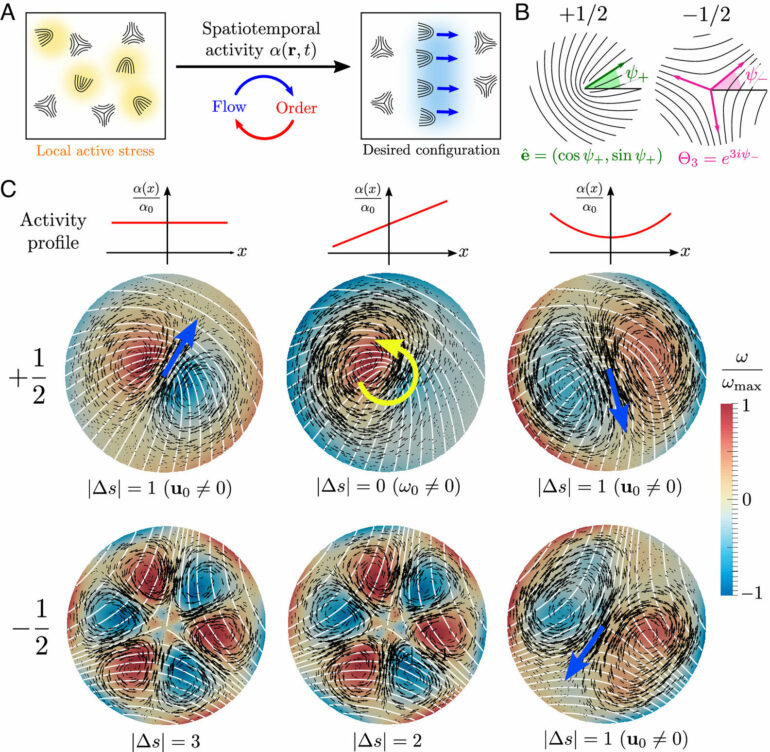University of Michigan physicists have devised a way to manipulate active fluids, a type of fluid composed of individual units that can propel themselves independently, by taking advantage of topological defects in the fluids.
The researchers showed that they could use tweezers similar to optical tweezers—highly focused lasers that can be used to nudge around atoms and other microscopic and submicroscopic materials—to manipulate the fluids’ topological defects and control how these active fluids flow. The study, led by U-M physicist Suraj Shankar, is published in the Proceedings of the National Academy of Sciences.
You can think of an active fluid like a flock of birds, says Shankar. In a murmuration, an enormous cloud of starlings, birds will twist and turn in unison, making shapes of the cloud. But while the murmuration looks like it’s moving as one organism, the movement is made of individual birds powered by their individual sets of wings.
Similarly, active fluids are composed of individual components like bacteria in water or atoms in a crystal, but each unit moves on its own if shone with light or given “food” via a chemical reaction, according to Shankar. Researchers have previously engineered bacteria so that when they shine light on the bacteria, some bacteria in the liquid swim faster and others swim slower.
“And you can change that pattern as you want. By changing the speed at which the bacteria swim locally, you can paint faces of famous people, or change it and make a landscape,” said Shankar, an assistant professor of physics at U-M.
“Given that these experimental platforms exist and we’re now able to manipulate these materials by controlling the speed by which things are moving around, we asked: Can we develop a framework in which we can control the local speeds of things that comprise active fluids so that we can control them in a systematic way?”
The research team also includes co-authors Cristina Marchetti and Mark Bowick of the University of California Santa Barbara and Luca Scharrer, who conducted much of the research as an undergraduate at UCSB.
The team focused on a popular active fluid called a nematic fluid, composed of liquid crystals—the same kind of liquid crystals that comprise smartphone, tablet and computer displays. These liquid crystals are fluids composed of long molecules that can line up and become ordered like matches in a matchbox or timber logs stacking up and flowing down a river, Shankar says.
But when driven by chemical reactions these nematic fluids become active and have the ability to pump fluid, which allows them to move around without externally applied forces or pressure gradients.
Shankar and colleagues used this characteristic feature and applied principles of symmetry, geometry and topology from mathematics to develop design principles that will allow the researchers to control the trajectory of individual crystals within the nematic fluids.
Their methods rely on differences in how these rod-like objects line up within the liquid. They may be misaligned at some points, which causes the liquid crystals to bend around the point of misalignment, like a whirlpool in a river.
This creates different patterns in the fluid, similar to the ridges of your fingerprints, Shankar says. In liquid crystals, there are points where the line of crystals will bend over and look like a comet, or form a symbol that looks like the Mercedes logo.
If you add energy to the system and make the fluid active, these patterns, called topological defects, come alive.
“These patterns start moving and they drive and stir the fluid, almost as if they were actual particles,” Shankar said. “Controlling these individual patterns that are associated with the defects seems like a simpler job than to control each microscopic component in a fluid.”
The project began when Scharrer developed simulations to model active fluid flow and track the locations of topological defects, attempting to test a hypothesis posed by Shankar and Marchetti. Showing his simulation results to the other researchers, Scharrer and the team found how these complex responses could be mathematically explained and converted into design principles for defect control.
In the study, Scharrer created ways to create, move and braid topological patterns using what they call active topological tweezers. These tweezers can transport or manipulate these defects along space-time trajectories as if they were particles, by controlling the structure and extent of the regions where chemical activity drives fluid pumping. The resulting motion of the active fluid around the whirlpools of the topological defects enables their never-ending movement.
“I think this work is a beautiful example of how curiosity-driven research, compared to problem- or profit-driven work, can lead us in completely unexpected technological directions,” said Scharrer, now a doctoral student at the University of Chicago.
“We started this project because we were interested in the fundamental physics of topological defects, and accidentally stumbled into a new way to control active biological and bio-inspired fluids. If we’d had that end goal in mind from the beginning, who knows if we would have found anything at all.”
The researchers also demonstrate how simple activity patterns can control large collections of swirling defects that continually drive turbulent mixing flows.
Shankar says while the field is new, and their method is proven using computational models at this point, some day people could use this concept in creating micro testing systems for diagnostic purposes or for creating tiny reaction chambers. Another potential application could be in the field of soft robotics or soft systems, in which computing capabilities could be distributed throughout soft, flexible materials.
“These are unusual kinds of fluids that have very exciting properties, and they pose very interesting questions in physics and engineering that we can hopefully encourage others to think about,” Shankar said.
“Given this framework in this one system that we demonstrate, hopefully others can take similar ideas and apply it to their favorite model and favorite system, and hopefully make other discoveries that are equally exciting.”
More information:
Suraj Shankar et al, Design rules for controlling active topological defects, Proceedings of the National Academy of Sciences (2024). DOI: 10.1073/pnas.2400933121
Provided by
University of Michigan
Citation:
Researchers show how to use ‘topological tweezers’ to control active fluids (2024, May 22)



